June 6-12 2016
One week of coastal education at the University of Oregon’s Institute of Marine Biology in Charleston, OR was more then I could have asked for. We had a thorough introduction to Coastal ecology which included the ocean to the coastal forests.
Some of us stayed on campus in the dorms. The nightly lectures were given in the Boathouse nearby. Each night before the next days field trip we were treated to a lecture on the ecoregion we were going to see— It was very helpful to know that information ahead of time.
Day 1
Nora Terwillger, who is faculty at OIMB was our first speaker and guide for the tidepool trip the following day. She covered many of the creatures we would be seeing and tidal pool ecology.
Day 2
We drove out to Cape Argo, South Cove to inspect the tidal pools. It was a clear beautiful day. We were there during a very lowtide so had all morning to clamber over the rocks. We found starfishes, sea urchins, corals, crabs, ribbon worm and chitons to name a few. We even saw the gumboot chiton, the biggest chiton of them all, as well as lots of different algae, one in particular I loved the name, Dead Man’s fingers…the cylindrical black branches looked very dead finger like. I was lucky enough to see a brittle star, which one of the assisting students at OIMB found at the base of a seaweed clump. While observing the ravines of mussels we were also treated to a pair of whales further out in the ocean also feeding in the area and coming up for air every now and again.
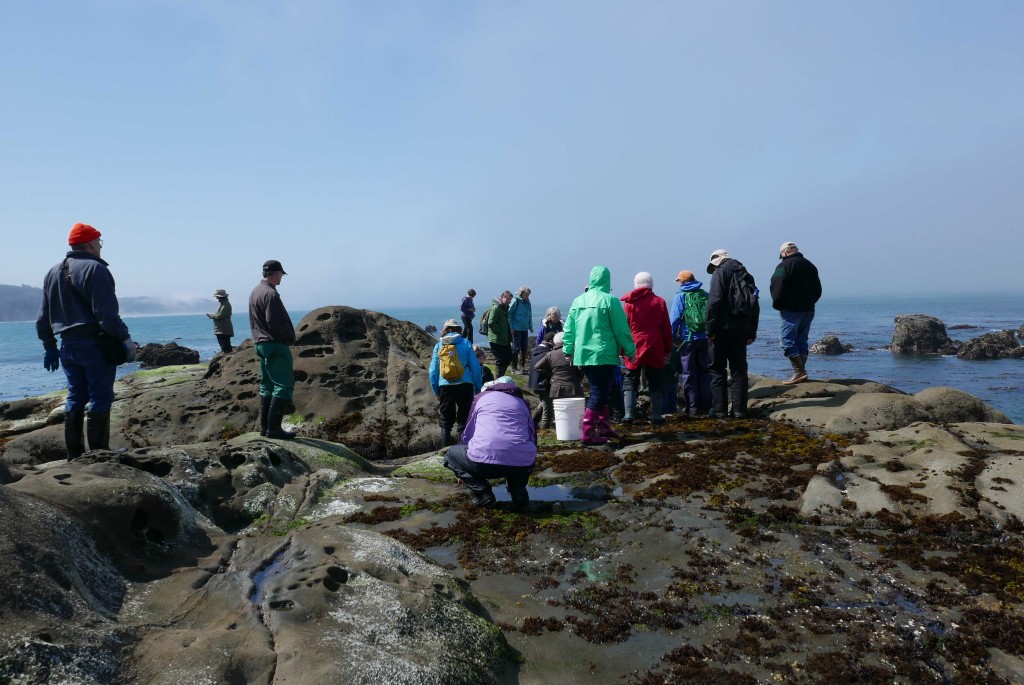
Tidepools and whale watching
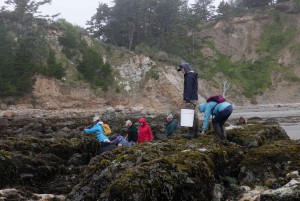
Very low tide
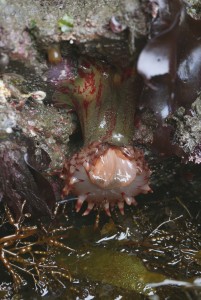
Anemone found exposed under the large rock
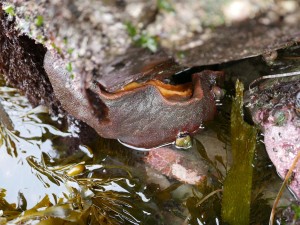
Gumboot chiton
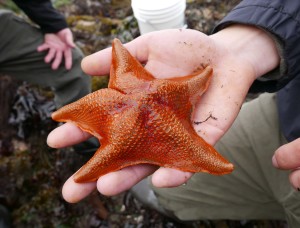
Batstar
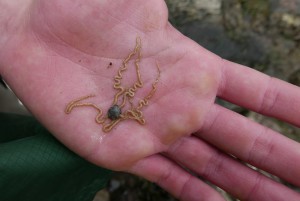
Brittle star
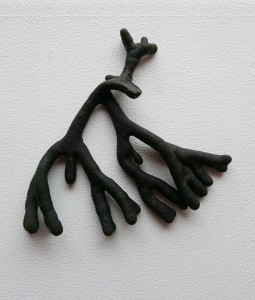
Deadman’s fingers
In the afternoon we had a lecture about the Dunes for the next days location.
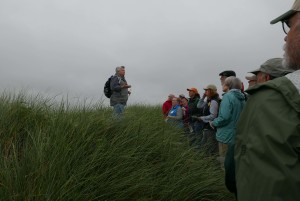
Lecture on the dunes
Day 3
Bright and early we headed out the next day to Horsefall Beach and John Dellenback to walk on the dunes and through the surrounding vegetation.
Our guide Marty Giles was an excellent speaker. “We learned that Sand is not a thing but a size”, “60% of shoreline is Sand and 40% are magnificent Sand dunes”. I learned that larvae inhabit the spaces between the grains of sand, which might explain why on some beaches my feet can be quite itchy after walking on the sand. We compared the sand composition from the beach to the sand dunes, noting different colors and observed the various granular compositions found in sand from different locations. I learned about tree decomposition chimneys, old original trees that were covered up by the dunes and now are slowly rotting to expose a cavity that the sand will fill eventually. Or they also may still be hollow but with a thin film of sand over them. If you stepped on a decomposed tree chimney that hadn’t yet filled with sand you would sink in the hole. We also learned about the tough plants that can live in this windy, salty environment. We then entered the costal forests along the edge of the dunes to see what species of plants were coping in that Ecoregion. The ever-advancing dunes have over the centuries covered up large areas of Oregon’s coastal forests, which you can see from Highway 101.
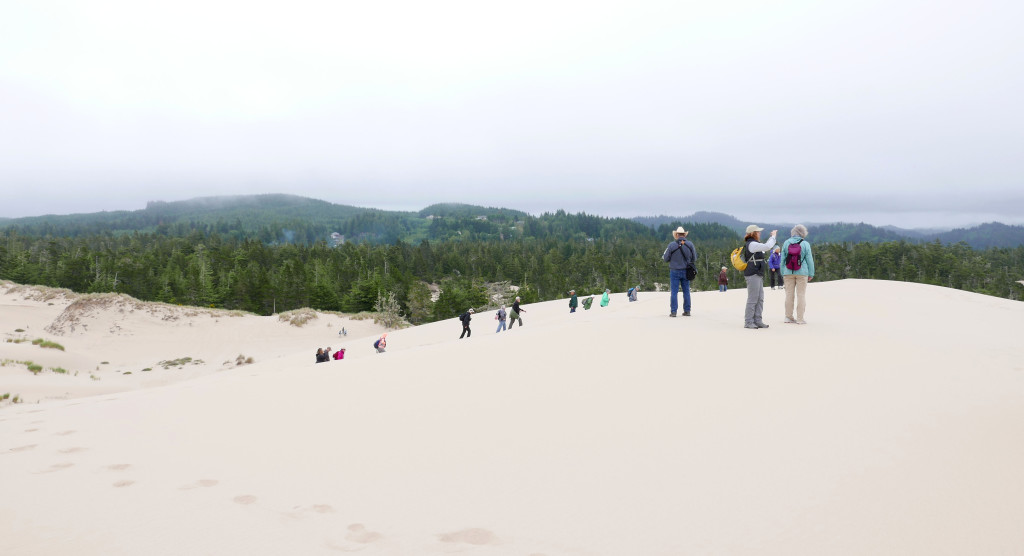
Hiking to the top of one of the large sand dunes.
In the evening we had an extensive lecture on ocean currents, tides, rip tides and more. Was hard to get my head around some of the processes but something worth knowing if you are a surfer, swimmer or have spent time on the water fishing or boating.
As part of the beach ecology we had a interesting lecture by Jennifer Kirkland, BLM on Snowy Plovers. They are trying to protect and bring back the population of Snowy Plovers on the spit in Coos Bay. So far they seem to be successful in increasing the population through very ingenious methods.
Day 4
We had a quick Estuary orientation by Joy Tally before heading out to the tidal flats near OIMB on the South Slough where it meets Coos bay. Armed with buckets, scoop nets and shovels we proceeded to find an amazing array of critters in the mud flats. I found a Jellyfish, and the group found, ghost shrimp, crabs, oysters, and other small zooplanktons like the ctenophore. There was also a worm like creature, Phronid that buries itself in the mud, and the sculp whose amphipod inside was inspiration for the alien in the movie Alien. They were among the more bizarre creatures. A Gaper oyster has two small pea crabs that live inside it. They have a commensal relationship with the Gaper oyster where one species benefits with little or no harm to the other. It is amazing what you can find in the mud flats. Along the edge of the flats I found a ‘pickle weed’, a plant I had not seen before, along with a Castilleja sp.
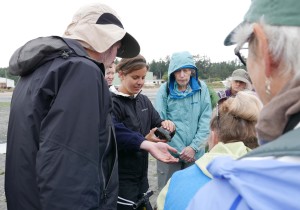
Oyster
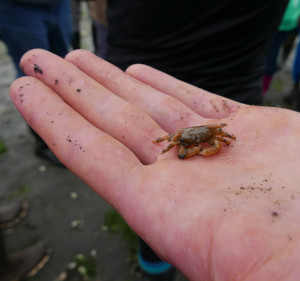
Small crab living in the Gaper oyster
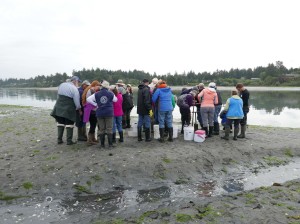
Mudflats
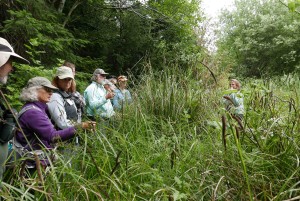
South Slough walk
In the afternoon we had a field trip to the South Slough National Research Reserve. We had a brief lecture by Bree Yednock about the slough and the restoration work they are undertaking to restore the original stream channels, marshes and vegetation back to where it was before humans altered the ecology of the area. The rest of the afternoon we did a short walk through the area to see the restoration and future plans for the slough marshes..
We also got to try our hand at conducting a plant survey in the Marsh.
Our lecture for the evening was about interpreting by Trish Mace and Marty Giles
Day 5
We started off on a short boat trip in Coo’s bay collecting Plankton in the net we were dragging behind the boat. The afternoon was then spent looking at the plankton through microscopes under the watchful eye of Svetlana Maslakova…not only were there plankton but also the very weirdly shaped larvae of various creatures including crabs.
In the afternoon we had a lecture by Jan Hodder on the bird and animal life on the offshore islands. Information for our next days field trip.
Day 6
We went to Coquille Point near Bandon and looked for all the birds and mammals we had just learned about the day before. Spotting telescopes provided by SEA volunteers let us see the birds nesting on the top of the off shore rocky islands. Black Oyster catchers, Common Murre, Brandt’s cormorant, and Pelagic Cormorant. Also the harbor seals were lounging on the rocks below the nesting birds.
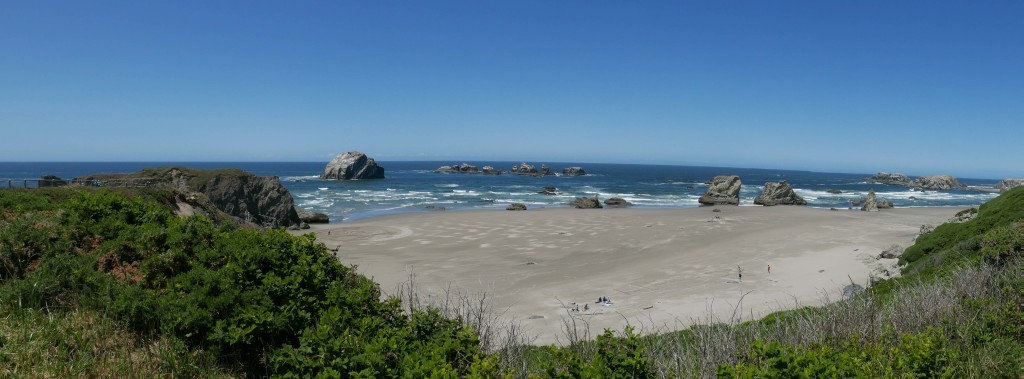
After lunch we had an excellent lecture by Nicole Norris, on the Human History of the area, their history before and after colonization. There were many things I did not know about the tribes on the west coast, their life style, language, traditions and treatment by the colonists. They seemed to have had a vastly different history and treatment by the colonists then the tribal peoples in the areas west of the Cascades. Before the disruption of foreigners, they enjoyed a unique environment. At their doorstep were the ocean and forests, which provided a constant rich food source and shelter.
In the evening our lecture was given by Ron Metzger on the Geology of the coastal area.
Day 7 Last day…
We spent the morning at Cape Argo looking at the rock formations off the coast. We stopped at various points on our way back to OIMB with Ron pointing out geological formations off and on the coast. Looking out at the rock islands off shore you can see the tilt of the rocks from earlier earthquakes and tsunami events. And tree stumps on beaches from long buried forests the ocean sand is now swallowing up. Concretions were the rock formations I liked the best.
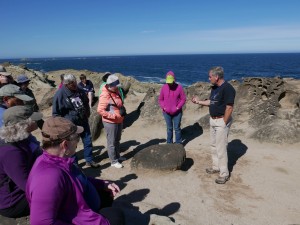
Talking about concretions
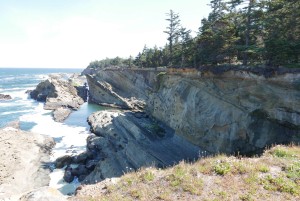
Exposed cliff showing tilted layers of rock and soil.
Over all we had a fantastic week, great group of people, great instructors. Even more than that we had fantastic weather, was sunny most of the time or at least not rainy and cold….

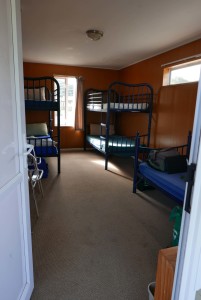
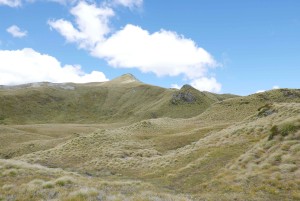


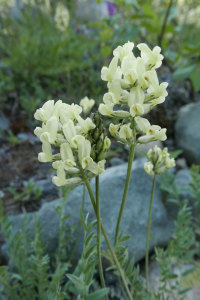
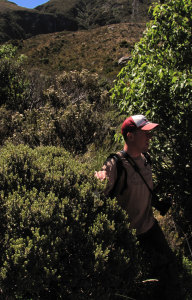














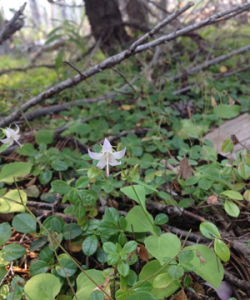 Recently I invited the artists from the Oregon Botanical Society to spend a weekend field sketching in our lovely forests in Bend, Oregon. It was a way for me to finally meet some of the members who live further a field. I enjoyed hosting this group of excellent artists and to have the privilege of showing them the beauty of the High Plateau and what Bend has to offer.
Recently I invited the artists from the Oregon Botanical Society to spend a weekend field sketching in our lovely forests in Bend, Oregon. It was a way for me to finally meet some of the members who live further a field. I enjoyed hosting this group of excellent artists and to have the privilege of showing them the beauty of the High Plateau and what Bend has to offer.